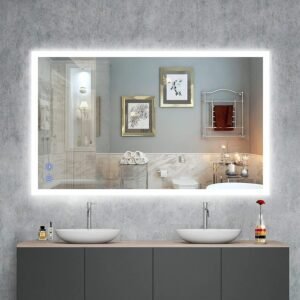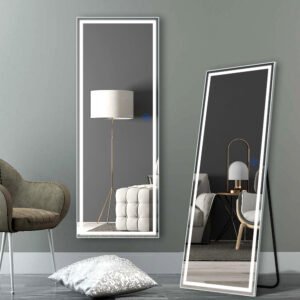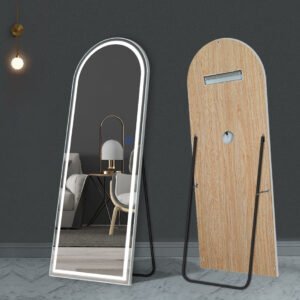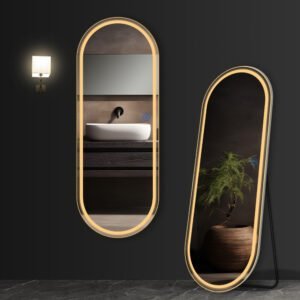Les miroirs de salle de bain LED sont un incontournable dans les maisons modernes et les espaces commerciaux, Amélioration de la lumière, fonctionnalité, et concevoir. Mais comme avec n'importe quoi, Quand ils se trompent, Ils peuvent être douloureux à dépanner. Si le problème est avec les lumières elles-mêmes, brouillard sur le miroir, Ou autre chose, Savoir comment résoudre le problème peut vous faire gagner du temps et des maux de tête.
Dans ce guide, Nous allons discuter du 10 commun Miroir de salle de bain LED problèmes et fournir des solutions pratiques à chacun, Vous aider à maintenir les performances et la longévité de votre miroir.

Table des matières
BasculerPourquoi mon miroir LED ne s'allume pas?
Le problème le plus frustrant que vous puissiez avoir, c'est quand votre miroir LED ne s'allume pas du tout. Cela est généralement dû à un simple problème de câblage ou à un grand lapin électrique.
Le problème le plus courant est que la puissance ne se connectera pas à votre Miroir LED. Cela pourrait être aussi simple que le câble qui n'est pas branché tout le chemin, ou le câble aurait pu être endommagé ou effiloché. D'abord, Vérifiez pour voir si votre miroir est branché.
Une autre source potentielle du problème pourrait être un problème avec le câblage à l'intérieur du miroir. Le pilote LED contrôle le flux de puissance vers les LED. S'il y a un problème avec le transformateur, le pilote LED ou le câblage dans le miroir, Il est préférable de vérifier la garantie et de contacter le fabricant pour une correction ou un nouveau.
Solution: Assurez-vous que la connexion d'alimentation est sécurisée. Testez la prise avec un autre appareil pour vous assurer que l'alimentation est disponible. Si la lampe ne fonctionne toujours pas, Il peut être nécessaire d'appeler un électricien pour vérifier le câblage ou remplacer le pilote LED ou le transformateur.
Dans de rares cas, Un interrupteur mural défectueux ou un gradateur pourrait être le problème. Quelques Miroirs LED Ne jouez pas bien avec certains types de gradateurs, provoquant une défaillance du système d'alimentation. Assurez-vous que vous utilisez les bons commutateurs conçus pour l'éclairage LED. Aussi, Vérifiez le disjoncteur pour vous assurer que le fusible n'a pas été déclenché en raison d'une surcharge. Si quelque chose sur le circuit a déclenché le disjoncteur, La réinitialisation du disjoncteur pourrait résoudre le problème.

Comment réparer les miroirs de salle de bain LED vacillants?
Les lumières vacillantes sont un autre problème courant avec les miroirs de salle de bain LED. En plus d'être ennuyeux, Le scintillement pourrait indiquer un problème électrique plus grave. Le scintillement se produit lorsque l'alimentation de la LED est incohérente, qui pourrait être causé par un câblage lâche ou un mauvais pilote LED.
Les possibilités incluent les fluctuations de puissance, Une connexion lâche, ou un pilote LED défectueux. Le pilote est l'appareil qui convertit le courant électrique standard en basse tension dont les LED doivent fonctionner correctement. Si le conducteur va mal, il peut envoyer une puissance irrégulière aux LED, Les faire scintiller.
Solution: D'abord, Vérifiez les connexions lâches dans le câblage. Si votre câblage est bon et que les connexions sont serrées, Le problème pourrait être le pilote LED. Si vous remplacez le pilote LED, Vos lumières LED ne doivent pas scintiller.
Contenu connexe: Parfois, un scintillement peut se produire en fonction de la qualité des composants LED utilisés dans le miroir. Les lumières LED de qualité inférieure ont tendance à scintiller plus souvent car elles ne gèrent pas les fluctuations de puissance ainsi que des lumières de meilleure qualité. Si votre Miroir LED continue de scintiller même après avoir remplacé le conducteur, Ensuite, vous devrez peut-être envisager de remplacer toute la bande LED par un éclairage de meilleure qualité. Aussi, Vous voudrez peut-être envisager d'installer un stabilisateur de tension dans votre maison si vous ressentez des surtensions fréquentes ou des chutes de puissance. Cela aidera à fournir une alimentation cohérente pour votre miroir LED.

Pourquoi mon miroir à LED est-il plus sombre que d'habitude?
L'éclairage faible est un problème courant avec les miroirs de salle de bain LED, D'autant plus que les lumières vieillissent. La luminosité des ampoules LED peut s'estomper avec le temps, Ce qui peut être ennuyeux si vous en dépendez pour des tâches comme le rasage, faire du maquillage, ou réparer vos cheveux.
La raison la plus courante pour laquelle vous ressenterez un faible éclairage est le vieillissement des LED ou pas assez de puissance en leur accédant. Au fil du temps, Les composants à l'intérieur des LED s'usent et ils ne brillent pas aussi brillamment qu'ils l'ont fait autrefois. Aussi, Si la tension de la puissance entrant dans les LED est faible, alors ils n'ont pas assez de puissance et ils brillent faiblement.
Solution: Vérifiez l'alimentation et assurez-vous que le miroir obtient la bonne tension. Si l'alimentation est bonne, Ensuite, il est probablement temps de remplacer les ampoules LED. Dans certains miroirs, La bande LED est remplaçable et tout ce que vous avez à faire est de les échanger. Dans d'autres miroirs, C'est un processus plus impliqué.
Contenu connexe: Si vos LED s'adhèrent lentement avec le temps, C'est probablement juste le taux de désintégration naturelle de vos LED. En moyenne, Une LED durera pour 50,000 heures avant de devoir la remplacer. Si votre Miroir LED commence soudainement à diminuer, Vous pouvez avoir un problème avec le transformateur ou le régulateur de tension. Vous devez vérifier les instructions du fabricant pour voir si vous pouvez remplacer ou mettre à niveau vos composants d'éclairage ou voir si vous avez une couverture de garantie pour vous aider avec les coûts de réparation ou de remplacement.

Comment résoudre les problèmes de brouillard miroir LED?
Un problème courant avec des miroirs réguliers dans une salle de bain est la brouillard. Miroirs de salle de bain LED, en particulier ceux qui ont des tampons de démens, sont conçus pour lutter contre ce problème, Mais cela peut encore arriver si la fonction anti-bug n'est pas allumée ou ne fonctionne pas correctement.
La brouillard se produit lorsque l'humidité dans la salle de bain s'accumule sur la surface du miroir, Surtout après une douche chaude. C'est un problème courant dans les salles de bains qui n'ont pas beaucoup de ventilation. C'est extrêmement frustrant si votre miroir LED s'avance.
Solution: De nombreux miroirs LED sont livrés avec un défogging Pad qui empêche la brouillard en chauffant doucement la surface du miroir. Assurez-vous simplement que cette fonctionnalité est activée. Si votre miroir LED n'a pas de démêlage, Envisagez d'en ajouter un. En outre, Prenez des mesures pour améliorer la ventilation dans votre salle de bain. Cela peut n'impliquer rien de plus que d'allumer le ventilateur d'échappement lorsque vous prenez une douche ou un bain.
Contenu connexe: Si vous utilisez un miroir de salle de bain ordinaire sans un tampon de défogging, Vous pouvez y appliquer un spray anti-brouillard pour réduire la condensation. Certaines personnes recommandent également d'utiliser du vinaigre et de l'eau lorsque vous nettoyez le miroir comme moyen d'éviter la brouillard. Enfin, Assurez-vous que votre salle de bain est correctement évacuée en utilisant un ventilateur ou en gardant une fenêtre ouverte pour laisser s'échapper l'humidité.

Que faire si le capteur tactile sur mon miroir LED cesse de fonctionner?
De nombreux miroirs de salle de bain LED modernes ont des capteurs tactiles. Vous touchez le miroir pour l'allumer, Touchez-le à nouveau pour l'éteindre et maintenez votre doigt vers le bas pour atténuer les lumières. C'est une fonctionnalité très pratique, Mais les capteurs tactiles peuvent se salir ou cesser de travailler d'un point de vue électrique.
Les capteurs tactiles peuvent échouer à cause de la saleté, interférence électrique, ou problèmes de câblage interne. La première chose à vérifier si votre capteur tactile s'éteint est de vous assurer que la zone est propre. La saleté ou l'humidité peut interférer avec le capteur et la rendre incapable de détecter votre toucher.
Solution: Si votre capteur sort, Vous pouvez essayer de nettoyer la zone où se trouve le capteur tactile, et voir si cela résout le problème. Si cela ne s'en occupe pas, Essayez d'éteindre l'alimentation vers le miroir, Et puis retirez-le. Si le capteur ne fonctionne toujours pas, Ensuite, vous devrez peut-être contacter le fabricant pour obtenir un capteur de remplacement ou quoi faire ensuite.

Pourquoi mon miroir LED produit-il du bruit?
Bien que vous n'obtenez généralement pas beaucoup de bruit des lumières LED, Quelques personnes rapportent entendre un son bourdonnant ou bourdonnant provenant du Miroirs de salle de bain LED. Normalement, Cela indique un problème avec le pilote LED ou les interférences électriques.
Les sons bourdonnants ou bourdonnants sont généralement le résultat d'un mauvais pilote LED ou d'une interférence électrique. Le conducteur est la chose qui régule l'électricité qui va aux lumières LED et quand il fonctionne mal, il peut le faire vibrer ou faire du bruit.
Solution: La meilleure façon de résoudre ce problème est de remplacer le pilote LED. Si le bruit provient de quelque chose qui fait cliquener à l'intérieur du miroir, essayez de serrer toutes les vis et les raccords.
Contenu connexe: Si le bruit continue, Cela pourrait être un cas d'interférence électrique dans votre maison. Vous devrez peut-être le mettre sur un autre circuit ou essayer un conditionneur de puissance. Les conducteurs LED de meilleure qualité sont moins susceptibles de produire du bruit, Donc, dépenser plus d'argent dans ce cas pourrait vous aider.

Comment éviter les dommages causés par l'eau sur les miroirs de salle de bain LED?
Parce qu'ils sont dans une salle de bain, Votre miroir LED pourrait courir le risque de se faire éclabousser d'eau, exposé à la vapeur, ou même coulé avec la condensation. Au fil du temps, L'humidité pourrait provoquer un dysfonctionnement du miroir ou même se détériorer.
Les lésions de l'eau se produisent lorsque l'humidité pénètre dans les composants électriques, ou lorsque l'humidité endommage le cadre du miroir, ce qui peut provoquer une rouille, court-circuites, ou dommages permanents aux lumières et capteurs LED.
Solution: Assurez-vous que le miroir est scellé tout autour, surtout là où le miroir LED rencontre le mur. Aussi, Ne mettez pas la chose à côté de l'évier ou de la baignoire, et assurez-vous de l'essuyer de temps en temps.
Contenu connexe: Si vous vivez dans une région avec une humidité élevée, Envisagez d'utiliser un déshumidificateur dans votre salle de bain. Quand il s'agit d'humidité, Plus la cote IP est élevée, qui signifie une protection d'entrée, le meilleur. Une cote IP plus élevée est la meilleure en ce qui concerne les zones à haute humidité car elle empêche l'eau et la poussière de pénétrer dans le miroir. Recherchez un miroir avec au moins un Ip54 notation, Ce qui signifie qu'il est à l'épreuve des éclaboussures et à utiliser dans la salle de bain.

Sont des miroirs de salle de bain LED durables?
La durabilité est une principale préoccupation pour quelqu'un qui achète un Miroir de salle de bain LED, Surtout parce que c'est dans votre salle de bain et que vous allez l'utiliser tout le temps.
Oui, Les miroirs LED sont très durables et durent généralement 50,000 heures ou plus. Comme tout appareil électronique, Combien de temps cela dure dépend de la façon dont vous vous en occupez et s'il est installé correctement.
Solution: Pour vous assurer que votre miroir LED dure le plus longtemps possible, Installez-le dans un endroit qui minimise l'exposition à l'eau et à la vapeur. Entretien régulier, comme le nettoyage du miroir et l'inspection du câblage, peut également prolonger sa durée de vie.
Contenu connexe: Assurez-vous que le miroir est fait de bons matériaux. Assurez-vous que le cadre ne rouille pas. Assurez-vous que les lumières LED sont étanches. S'ils répondent aux normes de sécurité et de durabilité pour l'industrie, Alors tu vas aller bien.
Conseils pour nettoyer le miroir de votre salle de bain LED
Le nettoyage d'un miroir de salle de bain LED nécessite un peu plus de soins que de nettoyer un miroir standard, Comme vous devez éviter d'endommager les lumières et les capteurs LED.
Pour garder votre miroir LED propre et en bon état de fonctionnement, Évitez d'utiliser des produits chimiques durs ou des matériaux abrasifs, Comme ceux-ci peuvent rayer le miroir ou endommager les composants électriques. Plutôt, Utilisez un chiffon à microfibre doux et une solution de nettoyage légère pour essuyer le miroir.
Solution: Vaporisez votre solution de nettoyage sur le tissu, pas le miroir. Ceci est particulièrement important si vous utilisez un nettoyeur de liquide parce que vous ne voulez pas que le liquide monte dans les composants LED. Soyez prudent autour du bord du miroir. La poussière et la crasse peuvent s'y accumuler. Parce qu'il y a des capteurs le long du bord du miroir, Vous voulez être aussi doux que possible lorsque vous le nettoyez. Exercer une prudence autour des capteurs tactiles et des bandes LED au bord du miroir.
Contenu connexe: Pour une finition sans séquence, Envisagez d'utiliser une solution de vinaigre-eau ou un nettoyant en verre spécialisé. Évitez les produits à base d'ammoniac, Comme ceux-ci peuvent corroder la surface du miroir ou endommager les composants LED. Le nettoyage régulier maintient non seulement votre miroir, mais aide également à prolonger la durée de vie des capteurs tactiles et des lumières LED.
Plus de détails: Comment nettoyer correctement les miroirs LED? Un guide complet
Prendre soin de votre miroir de salle de bain LED: Conseils de maintenance simples
Les miroirs de salle de bain LED sont relativement peu d'entretien, Mais il est avantageux de prendre quelques étapes simples pour les garder en bonne forme pour les années à venir.
L'entretien régulier consiste en un nettoyage, inspection des problèmes électriques, et remplacer les composants vieillissants. La poussière peut s'accumuler sur la surface et les capteurs du miroir, ce qui peut nuire à leur capacité à travailler correctement.
Solution: De temps en temps, Vérifiez le câblage et les connexions pour vous assurer que tout fonctionne comme il se trouve. Si vous remarquez des lumières scintillantes ou à rage, résoudre immédiatement le problème pour éviter des problèmes supplémentaires. Le remplacement des bandes LED vieillissantes ou la mise à niveau vers des composants plus récents peut également aider à améliorer les performances et à prolonger la durée de vie de votre miroir de salle de bain LED.
Contenu connexe: Si votre miroir LED est situé dans un environnement à haute humidité, Envisagez d'ajouter un coussin de défogging ou de passer à un modèle qui présente une technologie anti-buve intégrée. Vérifiez la cote IP du miroir pour vous assurer qu'elle est encore adéquatement protégée de l'humidité et de la poussière. Et n'oubliez pas de faire attention au poids et à la façon dont le miroir est installé. Une mauvaise installation peut entraîner des fissures ou des dégâts au fil du temps.

Résumé
En abordant ces problèmes communs et en suivant les conseils de maintenance, Vous pouvez garder votre miroir de salle de bain LED fonctionner correctement et avoir l'air super pour les années à venir. Prendre soin et réparer les choses au besoin est le meilleur moyen de tirer le meilleur parti de votre investissement dans cet accessoire de maison moderne.









